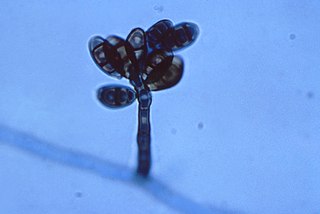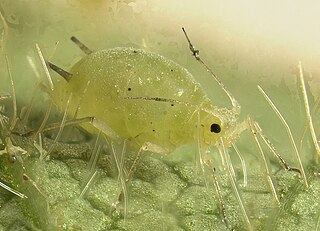
The soybean, soy bean, or soya bean is a species of legume native to East Asia, widely grown for its edible bean, which has numerous uses.

Glycine is a genus in the bean family Fabaceae. The best known species is the cultivated soybean. While the majority of the species are found only in Australia, the soybean's native range is in East Asia. A few species extend from Australia to East Asia . Glycine species are used as food plants by the larvae of some Lepidoptera species: the engrailed, nutmeg and turnip moths have all been recorded on soybean.
Isoflavones are substituted derivatives of isoflavone, a type of naturally occurring isoflavonoids, many of which act as phytoestrogens in mammals. Isoflavones are produced almost exclusively by the members of the bean family, Fabaceae (Leguminosae).

Curvularia is a genus of hyphomycete (mold) fungi which can be pathogens but also act as beneficial partners of many plant species. They are common in soil. Most Curvularia species are found in tropical regions, though a few are found in temperate zones.

The fungal genus Cochliobolus includes 19 species, it includes some plant pathogenic species such as Cochliobolus heterostrophus. A lot of former Cochliobolus species were transferred to either Curvularia or Bipolaris genera.
Bipolaris cactivora is a plant pathogen causing cactus stem rot and pitaya fruit rot.

Bipolaris incurvata is a plant pathogen that causes blight and leaf spots in coconut trees.

Cochliobolus carbonum is one of more than 40 species of filamentous ascomycetes belonging to the genus Cochliobolus. This pathogen has a worldwide distribution, with reports from Australia, Brazil, Cambodia, Canada, China, Congo, Denmark, Egypt, India, Kenya, New Zealand, Nigeria, Solomon Islands, and the United States. Cochliobolus carbonum is one of the most aggressive members of this genus infecting sorghum, corn and apple. As one of the most devastating pathogens of sweet corn, C. carbonum causes Northern leaf spot and ear rot disease while the asexual stage causes Helminthosporium corn leaf spot. Cochliobolus carbonum is pathogenic to all organs of the corn plant including root, stalk, ear, kernel, and sheath. However, symptoms of infection show distinct manifestations in different plant parts: whole plant - seedling blight affects the whole plant, leaf discoloration and mycelial growth, black fungal spores and lesions appear on inflorescences and glumes, and grain covered with very dark brown to black mycelium which gives a characteristic charcoal appearance due to the production of conidia.
Drechslera gigantea is a plant pathogen that causes eyespot disease on many host plants. There are Poa pratensis turfgrass cultivars that are resistant to D. gigantea, although that resistance is not as effective when stressed. In 2020, multilocus sequencing identified this pathogen as a member of the genus Bipolaris and proposed D. gigantea be transferred to Bipolaris gigantea.

Setosphaeria rostrata is a heat tolerant fungus with an asexual reproductive form (anamorph) known as Exserohilum rostratum. This fungus is a common plant pathogen, causing leaf spots as well as crown rot and root rot in grasses. It is also found in soils and on textiles in subtropical and tropical regions. Exserohilum rostratum is one of the 35 Exserohilum species implicated uncommonly as opportunistic pathogens of humans where it is an etiologic agent of sinusitis, keratitis, skin lesions and an often fatal meningoencephalitis. Infections caused by this species are most often seen in regions with hot climates like Israel, India and the southern USA.
Coniothyrium glycines is a fungal plant pathogen infecting soybean.
Septoria glycines is a fungal plant pathogen that causes leaf spot on soybean, a disease that is also known as brown spot. The disease leads to early defoliation of the plant, but does not normally cause severe reductions in yield. The fungus overwinters on infected soybean straw and is spread by wind dispersal or rain splash.
Drechslera andersenii is a fungus that is a plant pathogen. It was originally found on the leaves of Lolium perenne in Great Britain. It was also found on Italian ryegrass.

Pleosporaceae is a family of sac fungi. They are pathogenic to humans or saprobic on woody and dead herbaceous stems or leaves.

Bipolaris is a genus of fungi belonging to the family Pleosporaceae. It was circumscribed by mycologist Robert A. Shoemaker in 1959.

The soybean aphid is an insect pest of soybean that is exotic to North America. The soybean aphid is native to Asia. It has been described as a common pest of soybeans in China and as an occasional pest of soybeans in Indonesia, Japan, Korea, Malaysia, the Philippines, and Thailand. The soybean aphid was first documented in North America in Wisconsin in July 2000. Ragsdale et al. (2004) noted that the soybean aphid probably arrived in North America earlier than 2000, but remained undetected for a period of time. Venette and Ragsdale (2004) suggested that Japan probably served as the point of origin for the soybean aphid's North American invasion. By 2003, the soybean aphid had been documented in Delaware, Georgia, Illinois, Indiana, Iowa, Kansas, Kentucky, Michigan, Minnesota, Mississippi, Missouri, Nebraska, New York, North Dakota, Ohio, Pennsylvania, South Dakota, Virginia, West Virginia, and Wisconsin. Together, these states accounted for 89% of the 63,600,000 acres (257,000 km2) of soybean planted in the United States in 2007.
Fluminicola bipolaris is a fungal species in the family Papulosaceae of the Ascomycota. It was the only known species in the genus Fluminicola until 4 more new species were found in 2017 and 2021.

Glycine soja, known as wild soybean, is an annual plant in the legume family. It may be treated as a separate species, the closest living relative of the cultivated soybean, Glycine max, an important crop, or as a subspecies of the cultivated soybean, Glycine max subsp. soja.
Echinochlamydosporium is a fungal genus in the Mortierellaceae family of the Zygomycota. The genus is monotypic, containing the single species Echinochlamydosporium variabile, found in China. The fungus grows on juvenile individuals of the soybean cyst nematode.

Exserohilum is a genus of fungi in the family Pleosporaceae. The Exserohilum species are known for causing blight and human immune system diseases. The sexual reproductive states of Exserohilum species are known as Setosphaeria. The type species is Exserohilum turcicum. This genus is among three dematiaceous that are categorized for containing pathogens leading to diseases like phaeohyphomycosis.









